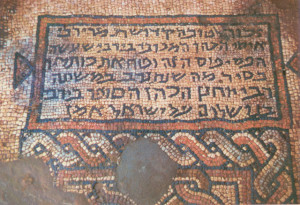 Excerpted from Lawrence H. Schiffman, From Text to Tradition, Ktav Publishing House, Hoboken, NJ, 1991.
Excerpted from Lawrence H. Schiffman, From Text to Tradition, Ktav Publishing House, Hoboken, NJ, 1991.
While it is certainly true that the great collections of so-called halakhic or tannaitic Midrashim were redacted mainly in the amoraic period, the content of these texts reflects the traditions and ideas of the tannaitic period. In amoraic times, a different type of aggadic Midrash, termed exegetical and homiletical, was developed. Whereas the
Midrashim of tannaitic times were primarily a product of the schoolhouse, those of amoraic times originated in the homilies of the synagogue, rapidly emerging in this period as the central institution of Jewish life. The exegetical Midrashim were a Palestinian product, as reflected in their Galilean Aramaic dialect (like that of the Aramaic portions of the Palestinian Talmud), and the constant allusions and attributions to Palestinian rabbis, many of whom are not known from the Talmuds.
The earliest of these Midrashim, those actually dating to the amoraic period, were edited in the fifth and sixth centuries. The exegetical type are arranged in scriptural order and, usually, proceed in a sustained manner verse by verse through the biblical book they treat. They include Genesis Rabbah, Lamentations Rabbah, Esther Rabbah I (i.e., the first part), Song of Songs Rabbah, and Ruth Rabbah. (Rabbah means, “the Great,” signifying the primacy of these Midrashim over other such collections.) The homiletical type of Midrash, made up of topically organized discourses, includes Leviticus Rabbah and Pesiqta de-Rav Kahana. The former provides comments on the first verse of each section of the Torah according to the triennial order of reading (a cycle by which the Torah is apportioned for public reading in the synagogue over three years). In the Pesiqta de-Rav Kahana homilies are provided for holidays and special occasions.
The amoraic Midrashim typically include a literary form known as the proem. A proem is an introduction to the midrashic exposition of a verse, usually the first verse of a specific Torah portion. It begins by citing a verse from elsewhere and then proceeds through a chain of interpretations until it arrives at the very first verse of the Torah reading, which it then identifies as echoing the notions derived in the previous exegesis. This rhetorical technique was a favorite one in the homiletical discourses given in the synagogues of Byzantine Palestine on Sabbath afternoons. As the midrashic collections were edited, proems were often invented to fill out the needs of the redactor where none had actually existed in the received tradition, thus giving rise to their ubiquity.
The redaction of the remaining “Rabbah” Midrashim–Exodus, Leviticus, Numbers, Deuteronomy, Ecclesiastes Rabbah, and Esther Rabbah II (i.e., the second part) as well as the texts of the Tanhuma type–belongs to a later period, beyond the scope of this book. Yet these works also preserve material from the amoraic period which can be dated with some accuracy by careful literary and historical analysis. These later aggadic compilations were more influenced by apocryphal, pseudepigraphal, apocalyptic, and mystical elements than those produced in amoraic Palestine, and also diverged from them in literary form and linguistic character. Indeed, Babylonian Jewry had a hand- in the later collections, and similar texts were still being redacted in Europe through the twelfth century.